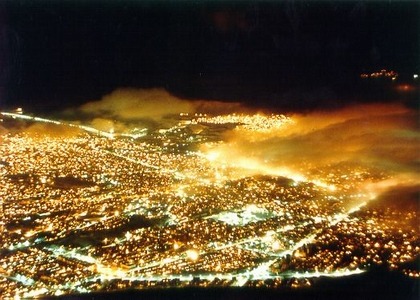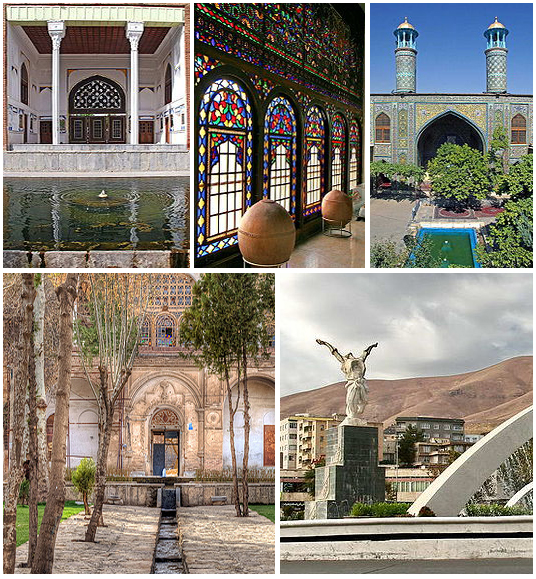
Sanandaj or Senna (Sine or Kursan as it is known by the majority of the locals) is the capital of the Iranian province of Kurdistan. The city of Sanandaj is the capital of the province, and lies at a distance of 512 km from Tehran, 1,480 m above sea level. It is also the administrative centre of Sannandaj County (the shahrestan of Sanandaj) as well as of a district (bakhsh) with the same name as the city. The population of Sanandaj is mainly Kurdish, with an Armenian, Assyrian and Jewish minority. People of Sanandaj speak a variation of Sorani Kurdish.
Name
The name "Sanandaj" is a variant of the Kurdish name "Sinedijh" (Sine fortress). The name of Senna, seems to be a contraction of Sadkania (100 springs), a title given to the medieval town of Sisar to avoid confusion with other towns named Sisar in the neighbouring regions. Sisar may be identified with Sisiri (or Sisirti) of the Assyrian period. Sisiri was a fortess on the land of Kharkhar (preserved in the name of the neighbouring Khorkhora River), on the frontier of the land of Ellipi.
History
Sanandaj is a rather new city and was built less than 400 years ago by the Ardalan principality in 17th century. After the Islamic conquest in AD 642, majority of the inhabitants accepted Islam. Today most inhabitants follow Sunni Islam which is the predominant religion. This differentiates this area from most of Iran which is primarily Shi'ah. Suleyman Khan Ardalan the governor of the region constructed the Sine dijh (castle) during the Shah Safi period (1629–1642). Sanandaj was under the control of the Ardalan household for four centuries. In the war between the Safavids and the Ottomans, this family sometimes sided with the Safavids and sometimes with the Ottomans. In 1733, Karim Khan Zand took control of the city. After a period of chaos, Khusrow Khan Ardalan took over power in this part of Kurdistan. From 1799 to 1824, Amanolah Khan Ardalan, son of Khusrow Khan Ardalan governed, ruled in Sanandaj. He worked to build up and inprove Sanandaj. In 1867, due to the dissatisfaction of the inhabitants, Haj Mirza Mu'tamid-u-lleh, the uncle of Nasser-al-Din Shah, came to power. He governed in the region until the year 1874. The main landmark of Sanandaj is a fortress dating back to the period of Abbasid rule. Sanandaj was very prosperous in the Safavid era. It was later chosen to be the capital of this province and is presently one of the most prominent cities of western Iran. A sizable Jewish minority settled down and thrived in Sanandaj due to the tolerant attitude of the Kurdish citizens plus the support of the ruling elite. A great majority of this Jewish community migrated to Israel by the end of 1980s.
Climate
Sanandaj has a pleasant weather in spring and summer.
The average seasonal temperature in Sanandaj is 15.20 °C in spring, 25.20 °C in summer,
10.40 °C in autumn and 1.60 °C in winter. In a 30-year long study carried out on the climate of Sanandaj,
the maximum absolute temperature was found to be 44 °C, the minimum absolute –31 °C,
and the average annual temperature 13.10 °C. The average relative humidity was 69% at 06:30 hours and 38% at 12:30 hours.
The average annual rainfall was 497.3 mm and the maximum daily, 61 mm. The average number of frosty days was 111.4;
and the maximum number of hours of sunshine over the entire year 2,786.2.

Attractions
Handicrafts
As in most other parts of Iran, carpet weaving is one of the most significant handicrafts of the region, especially in Bijar and Sanandaj. Shaw, kilim and jajim weaving. Wood work and jewelry and ornaments are among other main handicrafts of this province. The unique art of crafting backgammon boards utilizing genuine wood from walnut trees up to 1000 years old, mostly grown wild inside small valleys high up in the Zagros mountains must be noted. These magnificent trees were sadly overharvested during the past 50 years, exported to Europe, mainly to Italy.
The text of this article, and the images are from Wikipedia
Copyright © 2010 Kavan Soleimanbeigi. All rights reserved.
